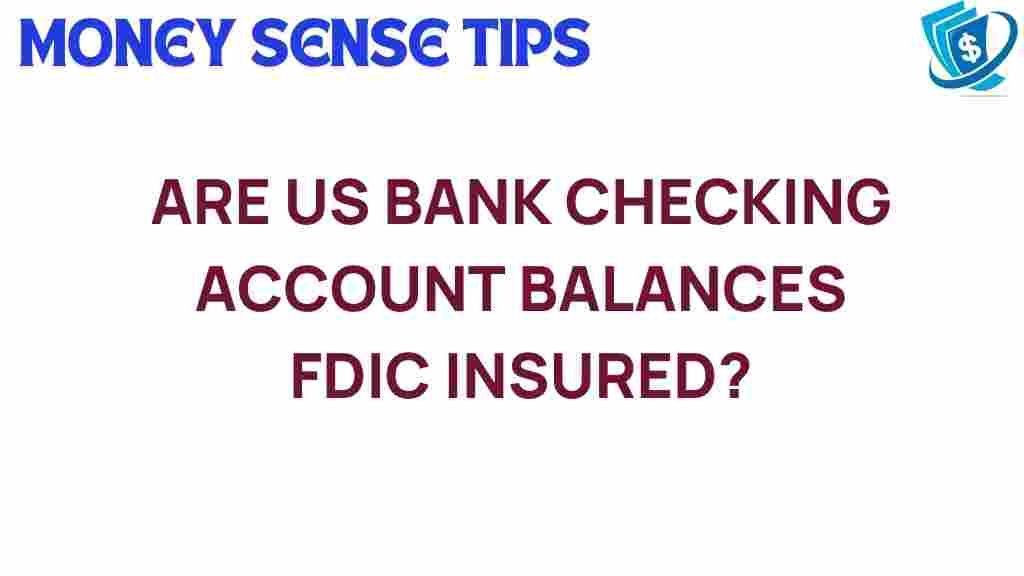Unpacking FDIC Insurance: Are Your US Bank Checking Account Funds Safe?
In today’s financial landscape, ensuring the safety of your funds is paramount. With the rise of digital banking and the complexities of the financial system, consumers are increasingly concerned about the security of their deposits. This is where FDIC insurance plays a crucial role. In this article, we will unpack the fundamentals of FDIC insurance, explore how it protects your US Bank checking account funds, and provide insights into financial security and consumer protection.
Understanding FDIC Insurance
FDIC, or the Federal Deposit Insurance Corporation, is an independent agency of the United States government that was created in 1933 in response to the thousands of bank failures during the Great Depression. The primary purpose of FDIC insurance is to maintain public confidence in the U.S. financial system by protecting depositors’ funds. Here are some key points about FDIC insurance:
- Coverage Limit: As of 2023, FDIC insurance covers up to $250,000 per depositor, per insured bank, for each account ownership category.
- Insured Products: FDIC insurance covers checking accounts, savings accounts, money market accounts, and certificates of deposit (CDs), but does not cover investment products like stocks, bonds, or mutual funds.
- Automatic Coverage: If you have a checking account at US Bank, your funds are automatically insured by the FDIC as long as the bank is a member institution.
The Importance of FDIC Insurance for Your US Bank Checking Account
When you deposit money into a US Bank checking account, you may wonder how this insurance affects the safety of your funds. Below are several reasons why FDIC insurance is critical:
- Financial Security: With FDIC insurance, you can rest assured that your deposits are safe, even if the bank faces financial difficulties.
- Bank Safety: The FDIC actively monitors the financial health of member banks, ensuring that they adhere to strict banking regulations that prioritize consumer protection.
- Peace of Mind: Knowing your funds are insured up to $250,000 allows you to focus on other aspects of your financial life without worrying about potential losses.
How FDIC Insurance Works
Let’s break down how FDIC insurance operates and what you need to know to ensure your funds are fully protected:
Step 1: Confirm Your Bank’s FDIC Membership
Before opening an account, it’s essential to confirm that your bank is FDIC insured. You can check the FDIC’s official website to verify your bank’s status. US Bank is a member of the FDIC, which means your deposits are covered under the insurance.
Step 2: Understand Ownership Categories
FDIC insurance coverage is calculated based on account ownership categories. Here’s a brief overview:
- Single Accounts: Owned by one person, covered up to $250,000.
- Joint Accounts: Owned by two or more people, each co-owner is insured up to $250,000, meaning a joint account could be covered for up to $500,000 or more, depending on the number of owners.
- Retirement Accounts: Such as IRAs, also insured up to $250,000.
Step 3: Diversify Your Accounts
If you have more than $250,000 in deposits, consider diversifying your funds across different ownership categories or banks to maximize your FDIC insurance coverage. For example, you might have:
- A personal checking account at US Bank.
- A joint savings account with a spouse at a different bank.
- A retirement account at another institution.
Step 4: Stay Informed About Changes
Banking regulations can change, and it’s essential to stay informed about any updates to FDIC insurance policies. Regularly review your bank statements and ensure you are aware of your coverage limits.
What Happens When a Bank Fails?
In the unlikely event that your bank fails, here’s how FDIC insurance works to protect your money:
- The FDIC steps in as the receiver for the failed bank.
- Depositors will typically have access to their insured funds within a few days.
- The FDIC will either transfer your deposits to a new bank or issue you a check for the insured amount.
It’s important to note that FDIC insurance does not cover investment losses, so always be cautious with investment products that are not insured.
Troubleshooting Common Concerns
Even with the protection offered by FDIC insurance, you may have some concerns about your banking experience. Here are some common issues and how to address them:
Concern 1: What if I exceed the $250,000 limit?
If your deposits exceed $250,000, consider spreading your funds across multiple banks or account types to ensure all your money is insured. Consult with a financial advisor for personalized strategies.
Concern 2: Are all my accounts covered?
Check the ownership categories of your accounts to confirm coverage. If you have multiple account types, review them to ensure they fall under different categories for maximum protection.
Concern 3: How do I file a claim?
In the rare case you need to file a claim, contact the FDIC directly or visit their website for guidance. They will provide information on how to proceed based on your specific situation.
Conclusion: Ensuring Your Financial Security
Understanding FDIC insurance is crucial for anyone with a US Bank checking account. By familiarizing yourself with how insurance works, the importance of bank safety, and the regulations in place for consumer protection, you can significantly reduce the risks associated with banking.
Remember, while FDIC insurance provides a robust safety net for your deposits, always practice good financial hygiene. Monitor your accounts regularly, stay informed about banking regulations, and don’t hesitate to seek advice when needed. For more information on banking safety and consumer protection, visit the FDIC’s official website.
With the right knowledge and strategies, you can confidently manage your finances, knowing your funds are safe and secure.
This article is in the category Accounts and created by MoneySenseTips Team
